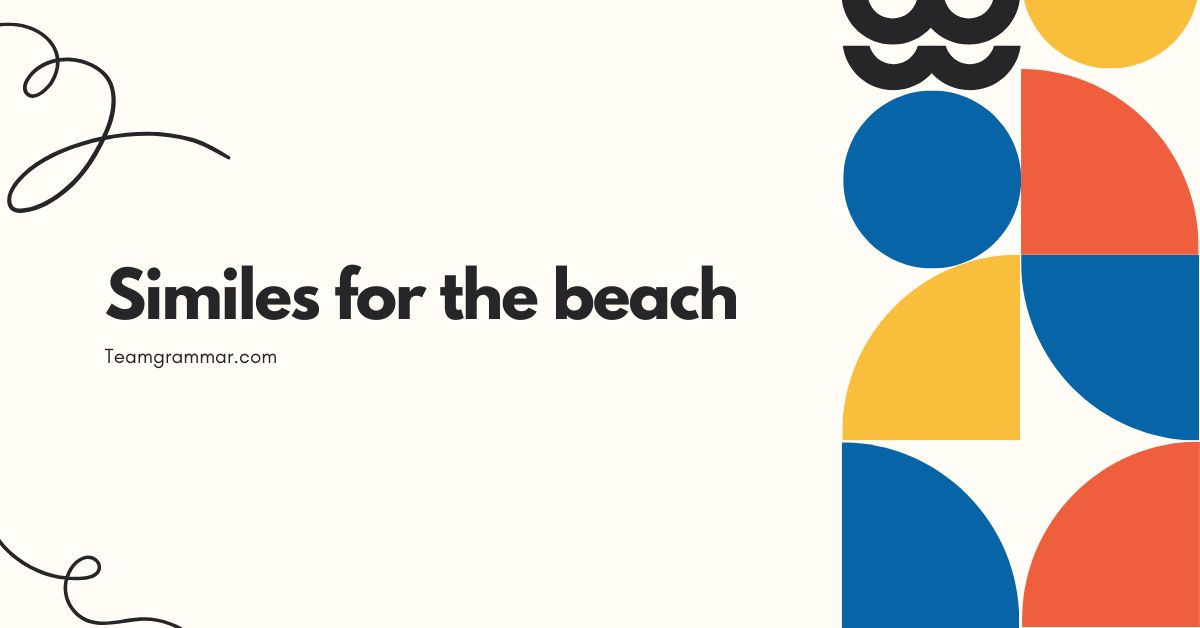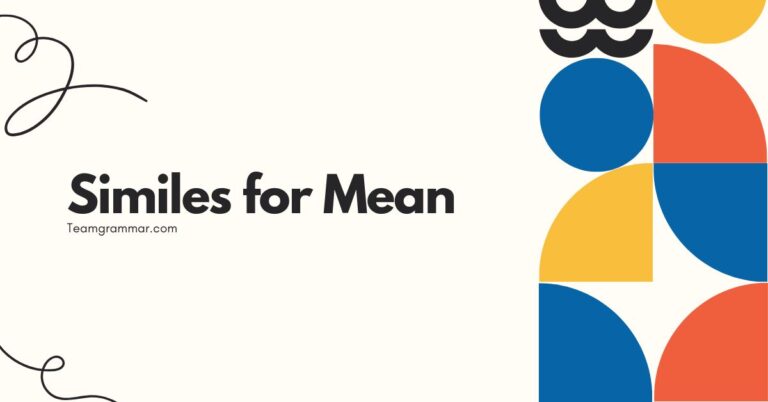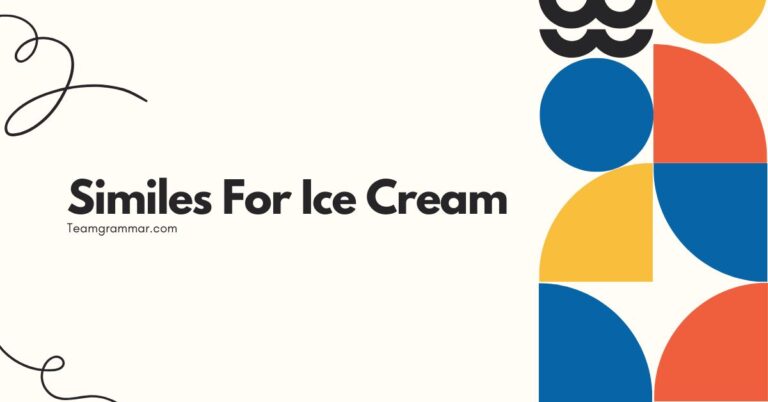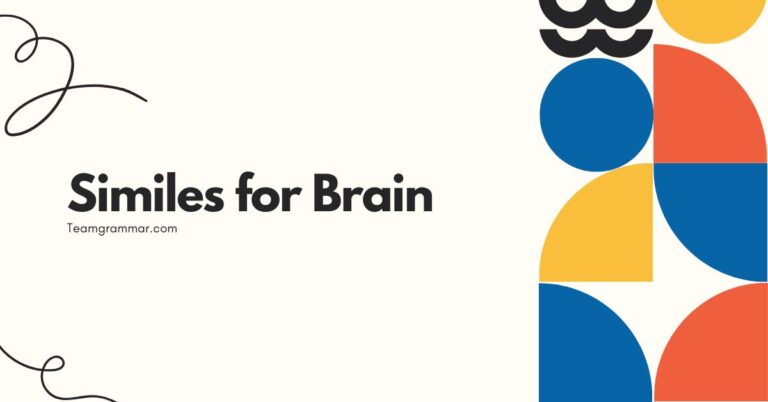41 Beach Similes: Seashells of Figurative Language
Similes are powerful tools in the English language, allowing us to create vivid comparisons and enhance our writing. The beach, with its diverse sensory experiences, provides a rich source of inspiration for similes.
Understanding how to effectively use similes, particularly when describing the beach, can significantly improve your descriptive writing and make your communication more engaging. This article explores the art of crafting beach similes, covering their definition, structure, types, and usage rules.
It also includes numerous examples, practice exercises, and advanced topics to help you master this essential literary device. Whether you’re a student, writer, or language enthusiast, this comprehensive guide will equip you with the knowledge and skills to create impactful and memorable beach similes.
Table of Contents
- Introduction
- Definition of Simile
- Structural Breakdown of Similes
- Types of Similes
- Examples of Beach Similes
- Usage Rules for Similes
- Common Mistakes with Similes
- Practice Exercises
- Advanced Topics in Similes
- Frequently Asked Questions (FAQ)
- Conclusion
Definition of Simile
A simile is a figure of speech that directly compares two different things, typically using the words “like” or “as.” Its primary function is to enhance description by creating a vivid and relatable image in the reader’s mind. Similes draw parallels between dissimilar objects or concepts, highlighting a shared quality or characteristic.
Unlike metaphors, which imply that one thingisanother, similes state that one thing islikeanother.
Similes are classified as a type of figurative language, specifically a trope, which involves altering the usual meaning of words. They are used extensively in literature, poetry, and everyday conversation to add color, depth, and clarity to communication.
The effectiveness of a simile depends on the strength and relevance of the comparison it makes. A well-crafted simile can transform a mundane description into something memorable and impactful.
Consider the example: “The ocean was as blue as sapphire.” This simile compares the color of the ocean to the color of a sapphire, creating a clear and striking image of the ocean’s blueness. The comparison helps the reader visualize the scene more vividly than simply stating, “The ocean was blue.”
Structural Breakdown of Similes
A simile typically consists of three main components: thesubject, thelinking word(usually “like” or “as”), and thecomparison. The subject is the thing being described, while the comparison is the thing it is being likened to.
The linking word establishes the relationship between the subject and the comparison. Understanding these components is crucial for constructing effective and grammatically correct similes.
The basic structure of a simile can be represented as follows: Subject + Linking Word + Comparison. Let’s break down each component further:
- Subject: This is the noun or noun phrase that the simile is describing. It’s the focal point of the comparison.
- Linking Word: This word connects the subject to the comparison. The most common linking words are “like” and “as.”
- Comparison: This is the noun or noun phrase that the subject is being compared to. It should share a relevant characteristic with the subject.
For example, in the simile “The waves crashed like thunder,” the subject is “waves,” the linking word is “like,” and the comparison is “thunder.” This structure clearly conveys the loudness and forcefulness of the waves by comparing them to the sound of thunder.
Another example is: “The sand was as hot as fire.” Here, the subject is “sand,” the linking word is “as,” and the comparison is “fire.” This simile effectively communicates the intense heat of the sand.
Types of Similes
Similes can be categorized based on the type of comparison they make. Some common categories include:
Descriptive Similes
These similes focus on comparing physical attributes such as color, size, shape, or texture. They aim to create a vivid sensory image in the reader’s mind.
Action Similes
These similes compare actions or behaviors, often highlighting the manner or intensity of the action. They add dynamism and movement to the description.
Emotional Similes
These similes compare emotions or feelings, helping to convey the intensity or nature of the emotional state. They add depth and emotional resonance to the writing.
Abstract Similes
These similes compare abstract concepts or ideas, often making complex or intangible things more understandable. They require more thought and creativity to construct effectively.
Understanding these different types of similes allows you to choose the most appropriate type for your descriptive needs and to create more nuanced and impactful comparisons.
Examples of Beach Similes
The beach provides a plethora of sensory experiences, making it an ideal subject for similes. Here are some examples of beach similes, categorized by the aspect of the beach they describe.
Similes Describing the Ocean
The ocean is a dynamic and multifaceted entity, offering numerous opportunities for simile creation. These similes capture its vastness, power, and beauty.
The following table provides a variety of similes describing the ocean, each capturing a different aspect of its character. From its color to its movement, these examples demonstrate the versatility of similes in portraying the ocean’s essence.
| Simile | Explanation |
|---|---|
| The ocean was as blue as a sapphire. | Compares the ocean’s color to the deep blue of a sapphire. |
| The waves crashed like thunder. | Compares the sound of the waves to the loud rumble of thunder. |
| The sea stretched out like a vast, liquid blanket. | Compares the ocean’s expanse to a wide, covering blanket. |
| The water was as clear as glass. | Compares the water’s clarity to the transparency of glass. |
| The ocean roared like a hungry beast. | Compares the ocean’s sound to the ferocious roar of a beast. |
| The tide pulled back like a retreating army. | Compares the receding tide to an army withdrawing from battle. |
| The waves danced like playful children. | Compares the movement of the waves to the joyful movements of children. |
| The sea was as calm as a sleeping giant. | Compares the ocean’s stillness to the peacefulness of a sleeping giant. |
| The ocean’s surface shimmered like a million diamonds. | Compares the sparkling surface of the ocean to the brilliance of diamonds. |
| The waves surged like restless energy. | Compares the waves’ forceful movement to uncontainable energy. |
| The ocean depths were as mysterious as the night sky. | Compares the unknown depths of the ocean to the enigmatic nature of the night sky. |
| The sea foam was as white as freshly fallen snow. | Compares the color of sea foam to the pure white of snow. |
| The ocean breeze felt like a gentle caress. | Compares the feeling of the breeze to a soft, loving touch. |
| The waves curled like the lips of a sneering giant. | Compares the shape of the waves to a sneering expression. |
| The ocean’s breath was as salty as tears. | Compares the saltiness of the ocean air to the taste of tears. |
| The sea birds cried like lost souls. | Compares the sound of the birds to the cries of lost spirits. |
| The ocean’s rhythm was as constant as a heartbeat. | Compares the regularity of the waves to the steady rhythm of a heartbeat. |
| The sea was as vast as my imagination. | Compares the ocean’s size to the limitlessness of imagination. |
| The ocean’s surface rippled like silk. | Compares the texture of the water to smooth silk. |
| The ocean was as unforgiving as time. | Compares the ocean’s relentless nature to the passage of time. |
| The crashing waves sounded like applause. | Compares the sound of the waves to the sound of applause. |
| The ocean current was as strong as a river. | Compares the strength of the ocean current to a river. |
| The ocean was as dark as a bottomless pit. | Compares the darkness of the ocean to a bottomless pit. |
Similes Describing Sand
Sand, with its granular texture and shifting nature, offers a unique set of descriptive possibilities. These similes capture the various qualities of sand, from its warmth to its consistency.
Here’s a table providing examples of similes that describe the sand, highlighting its texture, temperature, and color. These examples illustrate how similes can add depth and detail to your descriptions of the beach.
| Simile | Explanation |
|---|---|
| The sand was as hot as fire. | Compares the sand’s temperature to the intense heat of fire. |
| The sand felt like powdered sugar beneath my feet. | Compares the sand’s texture to the fine, soft texture of powdered sugar. |
| The beach was as white as snow. | Compares the color of the beach sand to the pure white of snow. |
| The sand was as coarse as sandpaper. | Compares the texture of the sand to the rough texture of sandpaper. |
| The sand dunes rose like golden mountains. | Compares the shape and color of the sand dunes to golden mountains. |
| The sand shifted like liquid gold in the sunlight. | Compares the movement and color of the sand to liquid gold. |
| The sand was as soft as a baby’s skin. | Compares the sand’s softness to the delicate skin of a baby. |
| The sand stuck to my skin like glitter. | Compares how the sand clings to the skin to the way glitter does. |
| The sand was as fine as dust. | Compares the grain size of the sand to the small particles of dust. |
| The sand sparkled like tiny diamonds. | Compares the sand’s shimmer to the sparkle of diamonds. |
| Walking on the sand was like walking on clouds. | Compares the feeling of walking on sand to the sensation of walking on clouds. |
| The sand was as dry as a desert. | Compares the dryness of the sand to the arid environment of a desert. |
| The wet sand was as firm as concrete. | Compares the firmness of wet sand to the solidity of concrete. |
| The sand cooled down like a fading ember. | Compares the cooling process of the sand to a fading ember. |
| The sand castles crumbled like ancient ruins. | Compares the crumbling of sand castles to the decay of ancient ruins. |
| The sand felt like a warm blanket on my feet. | Compares the sensation of the sand to the warmth of a blanket. |
| The sand was as yellow as butter. | Compares the color of the sand to the yellow hue of butter. |
| The sand flowed through my fingers like water. | Compares the way sand slips through fingers to the flow of water. |
| The sand was as inviting as a soft bed. | Compares the allure of the sand to the comfort of a bed. |
| The sand absorbed the sun like a sponge. | Compares the sand’s ability to soak up sunlight to a sponge. |
| The sand dunes stretched like sleeping giants. | Compares the shape and size of the dunes to sleeping giants. |
| The sand was as still as a photograph. | Compares the stillness of the sand to a photograph. |
| The sand felt like a million tiny pebbles. | Compares the texture of the sand to tiny pebbles. |
Similes Describing the Sky
The sky above the beach, with its shifting colors and cloud formations, is another excellent subject for similes. These similes capture the beauty and dynamism of the beach sky.
This table offers a range of similes describing the sky at the beach, from sunrise to sunset. By comparing the sky to familiar images, these similes help to create a vivid picture in the reader’s mind.
| Simile | Explanation |
|---|---|
| The sky was as blue as a robin’s egg. | Compares the color of the sky to the distinct blue of a robin’s egg. |
| The clouds floated like cotton balls in the sky. | Compares the appearance of the clouds to fluffy cotton balls. |
| The sunset was as colorful as a painter’s palette. | Compares the variety of colors in the sunset to a painter’s palette. |
| The sky was as gray as a battleship. | Compares the color of the sky to the gray of a battleship. |
| The sun shone like a giant spotlight. | Compares the intensity of the sun’s light to a spotlight. |
| The clouds raced across the sky like galloping horses. | Compares the speed of the clouds to the movement of galloping horses. |
| The sky was as clear as crystal. | Compares the clarity of the sky to the transparency of crystal. |
| The stars twinkled like diamonds scattered across black velvet. | Compares the stars’ sparkle to diamonds on black velvet. |
| The sunrise was as warm as a lover’s embrace. | Compares the warmth of the sunrise to a loving embrace. |
| The sky was as vast as the ocean below. | Compares the sky’s expanse to the vastness of the ocean. |
| The clouds were like brushstrokes on a canvas. | Compares the cloud formations to brushstrokes on a painting. |
| The sky was as ominous as a gathering storm. | Compares the foreboding nature of the sky to an approaching storm. |
| The moon hung like a silver coin in the sky. | Compares the shape and color of the moon to a silver coin. |
| The sky was as orange as a ripe mango. | Compares the color of the sky to the orange of a mango. |
| The clouds transformed like shapeshifting creatures. | Compares the changing shapes of the clouds to shapeshifting creatures. |
| The sky was as peaceful as a sleeping child. | Compares the serenity of the sky to a sleeping child. |
| The sun dipped below the horizon like a coin into a slot. | Compares the sun’s descent to a coin dropping into a slot. |
| The sky was as electric as a neon sign. | Compares the vibrancy of the sky to a neon sign. |
| The clouds were as heavy as lead. | Compares the weight of the clouds to the heaviness of lead. |
| The sky was as endless as a dream. | Compares the limitlessness of the sky to a dream. |
| The sunset painted the sky like a masterpiece. | Compares the colors of the sunset to a work of art. |
| The sky was as clear as a bell after the storm. | Compares the clarity of the sky after a storm to the sound of a clear bell. |
| The early morning sky was as pink as cotton candy. | Compares the color of the sky to the pink of cotton candy. |
Similes Describing Beach Activities
Beach activities, such as swimming, surfing, and sunbathing, can also be effectively described using similes. These similes capture the sensations and experiences associated with these activities.
Here is a table featuring similes that describe common beach activities. These examples demonstrate how similes can bring action and sensory details to your writing, creating a more immersive experience for the reader.
| Simile | Explanation |
|---|---|
| Swimming in the ocean felt like flying through liquid silk. | Compares the sensation of swimming to flying through smooth silk. |
| Surfing the waves was like riding a bucking bronco. | Compares the experience of surfing to riding a wild horse. |
| Sunbathing felt like being wrapped in a warm blanket. | Compares the sensation of sunbathing to the comfort of a warm blanket. |
| Building sandcastles was like creating miniature kingdoms. | Compares the act of building sandcastles to creating small kingdoms. |
| Walking along the beach felt like a meditation. | Compares the calming effect of walking on the beach to meditation. |
| Collecting seashells was like hunting for hidden treasures. | Compares the activity of collecting shells to searching for valuable items. |
| Playing beach volleyball was like a dance in the sand. | Compares the movements in volleyball to the grace of dancing. |
| Watching the sunset was like witnessing a miracle. | Compares the awe-inspiring nature of a sunset to a miracle. |
| The beach party was as lively as a carnival. | Compares the energy of the party to the excitement of a carnival. |
| The bonfire crackled like a hungry dragon. | Compares the sound of the fire to the sound of a dragon. |
| Building a sandcastle felt like sculpting a masterpiece. | Compares creating a sandcastle to sculpting art. |
| The children splashed in the water like playful seals. | Compares the children’s movements to playful seals. |
| Fishing off the pier felt like a patient waiting game. | Compares the activity of fishing to a game of patience. |
| The beachgoers strolled along the shore like ants in a line. | Compares the movement of people to ants in a line. |
| The kite soared through the sky like a colorful bird. | Compares the kite’s movement to a bird. |
| Relaxing on the beach was as peaceful as a nap in a hammock. | Compares the peacefulness to a nap in a hammock. |
| The waves crashed around me like a playful dog. | Compares the waves to a playful dog. |
| The seagulls swooped down like hungry hawks. | Compares the movement of seagulls to hawks. |
| The beachcomber searched for treasures like a detective. | Compares the search for treasures to a detective’s work. |
| The children laughed like the sound of wind chimes. | Compares the children’s laughter to wind chimes. |
| The beach barbecue smelled like a summer feast. | Compares the smell of barbecue to a feast. |
| The beach felt as crowded as a city street. | Compares the busyness of the beach to a city street. |
| The beach was as quiet as a library in the early morning. | Compares the quietness of the beach to a library. |
Usage Rules for Similes
Using similes effectively requires adherence to certain rules. These rules ensure that the similes are grammatically correct, logically sound, and contextually appropriate.
- Use “like” or “as”: Always use either “like” or “as” to establish the comparison. These words are essential for signaling that a simile is being used.
- Ensure logical comparison: The two things being compared should share a relevant characteristic. The comparison should make sense within the context.
- Avoid clichés: While familiar similes can be effective, overused similes (clichés) can make your writing seem unoriginal. Strive for fresh and creative comparisons.
- Maintain consistency: Ensure that the simile fits the overall tone and style of your writing. Inconsistent similes can disrupt the flow and impact the reader’s experience.
Furthermore, it’s important to consider the audience when using similes. A simile that is effective for one audience may not be as effective for another.
Tailor your similes to the knowledge and experiences of your intended audience.
For example, instead of saying “The sand was as hot as the sun” (which is a common cliché), you could say “The sand was as hot as a freshly baked pizza,” which is more specific and engaging.
Common Mistakes with Similes
Several common mistakes can undermine the effectiveness of similes. Being aware of these mistakes can help you avoid them and improve the quality of your writing.
Here’s a table illustrating common mistakes made when using similes, along with corrections and explanations. Understanding these errors can significantly improve your ability to craft effective similes.
| Incorrect | Correct | Explanation |
|---|---|---|
| The ocean is a blue sapphire. | The ocean is as blue as a sapphire. | This is a metaphor, not a simile. Similes require “like” or “as.” |
| The sand was hot like. | The sand was like fire. | “Like” must be followed by the thing being compared to. |
| The sky was as blue. | The sky was as blue as the ocean. | The comparison must be complete and logical. |
| The waves crashed like water. | The waves crashed like thunder. | The comparison should be meaningful and not state the obvious. |
| The sun was like fire, very hot. | The sun was like a giant spotlight. | Avoid unnecessary repetition and redundancy. |
| She ran as fast. | She ran as fast as the wind. | The comparison needs a point of reference. |
| The clouds were like clouds. | The clouds were like cotton balls. | A simile must compare two different things. |
| He is like strong. | He is as strong as an ox. | Use the correct grammatical structure with “as.” |
| The beach is good like. | The beach is like paradise. | The phrase needs to be grammatically complete. |
| The sand felt like warm. | The sand felt like a warm blanket. | The comparison needs a noun. |
Practice Exercises
These exercises will help you practice creating and identifying similes. Each exercise focuses on different aspects of simile usage.
Complete the following sentences with appropriate similes. This exercise challenges you to create your own similes, reinforcing your understanding of their structure and function.
| Question | Answer |
|---|---|
| The ocean was ___________. | The ocean was as blue as a sapphire. |
| The sand felt ___________. | The sand felt like powdered sugar. |
| The sky looked ___________. | The sky looked as clear as crystal. |
| The waves crashed ___________. | The waves crashed like thunder. |
| The breeze felt ___________. | The breeze felt like a gentle caress. |
| The sun shone ___________. | The sun shone like a giant spotlight. |
| The clouds floated ___________. | The clouds floated like cotton balls. |
| The beach was ___________. | The beach was as white as snow. |
| The children played ___________. | The children played like playful seals. |
| The seagulls cried ___________. | The seagulls cried like lost souls. |
Identify the similes in the following sentences. This exercise tests your ability to recognize similes within a given text.
| Question | Answer |
|---|---|
| The moon hung like a silver coin in the sky. | like a silver coin |
| The sand was as hot as fire. | as hot as fire |
| The clouds raced across the sky like galloping horses. | like galloping horses |
| Swimming in the ocean felt like flying through liquid silk. | like flying through liquid silk |
| The bonfire crackled like a hungry dragon. | like a hungry dragon |
| The stars twinkled like diamonds scattered across black velvet. | like diamonds scattered across black velvet |
| The ocean depths were as mysterious as the night sky. | as mysterious as the night sky |
| The waves danced like playful children. | like playful children |
| The sand flowed through my fingers like water. | like water |
| The beach party was as lively as a carnival. | as lively as a carnival |
Advanced Topics in Similes
For advanced learners, exploring the nuances of similes can lead to a deeper understanding of figurative language. This includes studying extended similes, which are similes that are developed over several sentences or even paragraphs, and considering the cultural and historical contexts of similes.
Another advanced topic is the use of similes in different genres of writing. For example, similes in poetry often have a different purpose and style than similes in scientific writing.
Understanding these differences can help you use similes more effectively in various contexts.
Additionally, exploring the relationship between similes and other figures of speech, such as metaphors and analogies, can provide a more comprehensive understanding of figurative language as a whole.
Frequently Asked Questions (FAQ)
This section addresses common questions about similes, providing clear and concise answers to help you deepen your understanding.
- What is the difference between a simile and a metaphor?
A simile directly compares two things using “like” or “as,” while a metaphor implies that one thing is another. Similes are more explicit in their comparison, while metaphors are more implicit.
- Can a simile be a cliché?
Yes, a simile can become a cliché if it is overused and loses its originality. It’s best to avoid common similes and strive for fresh and creative comparisons.
- How do I create a strong simile?
To create a strong simile, ensure that the comparison is logical, relevant, and vivid. Choose comparisons that create a clear and memorable image in the reader’s mind.
- What are some common linking words besides “like” and “as”?
While “like” and “as” are the most common, other words such as “than,” “resembles,” and “similar to” can also be used to create similes in certain contexts.
- Is it okay to use similes in formal writing?
Yes, similes can be used in formal writing, but they should be used sparingly and with careful consideration of the audience and context. Avoid overly informal or colloquial comparisons.
- How can I avoid using clichés in my similes?
To avoid clichés, think outside the box and consider unusual or unexpected comparisons. Try to find unique qualities or characteristics that connect the two things you are comparing.
- Can a simile be used to describe abstract concepts?
Yes, similes can be used to describe abstract concepts by comparing them to more concrete or relatable things. This can make abstract ideas more understandable and accessible.
- What is an extended simile?
An extended simile is a simile that is developed over several sentences or paragraphs. It explores the comparison in greater detail and adds depth to the description.
- How do you identify a simile in a sentence?
Similes are typically identified by the presence of the words “like” or “as,” which signal a direct comparison between two different things.
- Why are similes important in writing?
Similes are important because they enhance description, create vivid imagery, and make writing more engaging and memorable. They help readers connect with the text on a deeper level.
Conclusion
Mastering the art of crafting similes can significantly enhance your descriptive writing and communication skills. By understanding the definition, structure, types, and usage rules of similes, you can create vivid and impactful comparisons that resonate with your audience.
The beach, with its rich sensory experiences, provides a wealth of inspiration for simile creation. Remember to avoid clichés, ensure logical comparisons, and tailor your similes to the specific context and audience.
Continue to practice creating and identifying similes in your reading and writing. Experiment with different types of comparisons and explore the nuances of figurative language.
With consistent effort, you can harness the power of similes to transform your writing and make your communication more engaging and memorable. The ability to craft effective similes is a valuable skill that will serve you well in various aspects of your personal and professional life.







